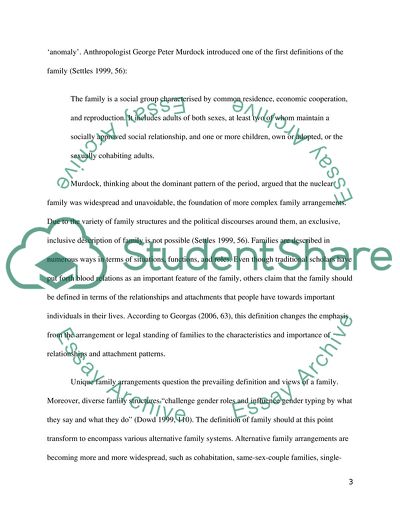Cite this document
(The Family in Contemporary Society Report Example | Topics and Well Written Essays - 3500 words - 1, n.d.)
The Family in Contemporary Society Report Example | Topics and Well Written Essays - 3500 words - 1. https://studentshare.org/sociology/1771930-what-is-a-family-and-what-are-they-like-in-contemporary-society-take-an-issue-of-the-family-that-you-have-studied-and-demonstrate-how-and-why-family-relations-are-so-significant-in-influencing-the-direction-of-our-lifes
The Family in Contemporary Society Report Example | Topics and Well Written Essays - 3500 words - 1. https://studentshare.org/sociology/1771930-what-is-a-family-and-what-are-they-like-in-contemporary-society-take-an-issue-of-the-family-that-you-have-studied-and-demonstrate-how-and-why-family-relations-are-so-significant-in-influencing-the-direction-of-our-lifes
(The Family in Contemporary Society Report Example | Topics and Well Written Essays - 3500 Words - 1)
The Family in Contemporary Society Report Example | Topics and Well Written Essays - 3500 Words - 1. https://studentshare.org/sociology/1771930-what-is-a-family-and-what-are-they-like-in-contemporary-society-take-an-issue-of-the-family-that-you-have-studied-and-demonstrate-how-and-why-family-relations-are-so-significant-in-influencing-the-direction-of-our-lifes.
The Family in Contemporary Society Report Example | Topics and Well Written Essays - 3500 Words - 1. https://studentshare.org/sociology/1771930-what-is-a-family-and-what-are-they-like-in-contemporary-society-take-an-issue-of-the-family-that-you-have-studied-and-demonstrate-how-and-why-family-relations-are-so-significant-in-influencing-the-direction-of-our-lifes.
“The Family in Contemporary Society Report Example | Topics and Well Written Essays - 3500 Words - 1”. https://studentshare.org/sociology/1771930-what-is-a-family-and-what-are-they-like-in-contemporary-society-take-an-issue-of-the-family-that-you-have-studied-and-demonstrate-how-and-why-family-relations-are-so-significant-in-influencing-the-direction-of-our-lifes.


